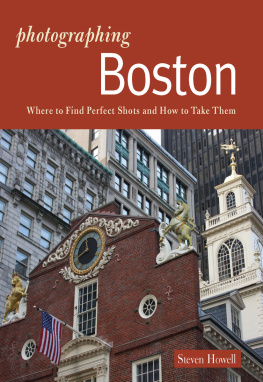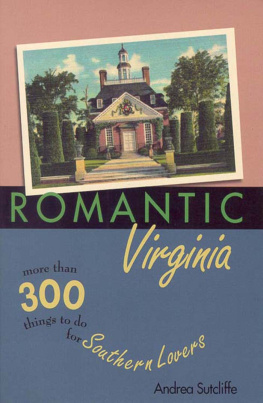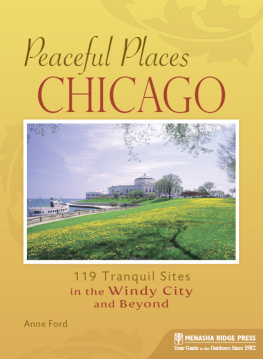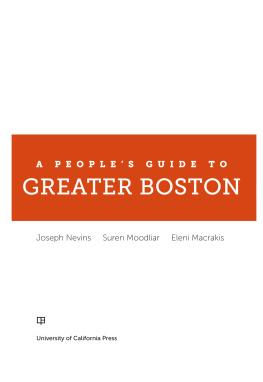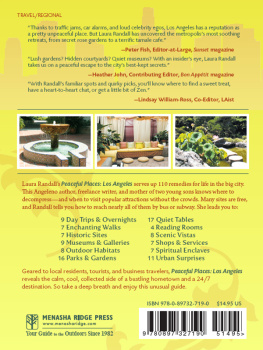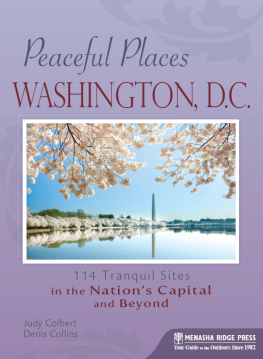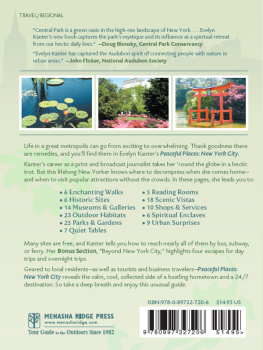Other titles of interest
Peaceful Places: Chicago
Peaceful Places: Los Angeles
Peaceful Places: New York City
Peaceful Places: San Francisco

Peaceful Places: Boston
Copyright 2012 by Lynn Schweikart
All rights reserved
Published by Menasha Ridge Press
Printed in the United States of America
Distributed by Publishers Group West
First edition, first printing
Cover design by Scott McGrew
Text design by Annie Long
Cartography by Steve Jones
Unless otherwise noted, all cover, back cover, and interior photographs by Lynn Schweikart
Back cover, center photograph: Thomas Lingner, 2008. Back cover, right photograph: Japan: Buddhist
Temple Room at the Museum of Fine Arts, Boston; photograph Museum of Fine Arts, Boston
Cover: For a peaceful time to visit .
Library of Congress Cataloging-in-Publication Data
Schweikart, Lynn.
Peaceful places, Boston: 120 tranquil sites in the city and beyond/Lynn Schweikart.
p. cm.(Peaceful places)
Summary: The fifth in a new series, each one set in a U.S. metropolis, Peaceful Places: Boston leads the reader on an unexpected path to secret delights shared by its insider author. This new title in an unusual guidebook series is for everyone who yearns for a little peace and quiet amidst the urban hubbub. The book entices readers with 120 tranquil oases, in Boston and beyond. There are enchanting walks, historic sites, museums and galleries, outdoor habitats, parks and gardens, quiet tables, spiritual enclaves, inspiring vistas, and urban surprises, all described from the perspective of a local who knows where to find serenity, in both familiar and unexpected placesProvided by publisher.
ISBN-13: 978-0-89732-542-4 (pbk.)
ISBN-10: 0-89732-542-7 ()
1. Boston (Mass.)Guidebooks. 2. Quietude. I. Title.
F869.M394S38 2011
917.44610444dc23
2011041986
Menasha Ridge Press
P.O. Box 43673
Birmingham, Alabama 35243
menasharidge.com
Disclaimer
Seclusion can be part of the charm of a peaceful place. Likewise, in some locations, the best time to visit is early morning, sunset, or even in the evening, when few other people are around. Therefore, we remind you to maintain awareness and practice caution in all of the destinations described in this book just as you would when venturing to any isolated or unfamiliar location.
Also, every effort has been made to ensure the accuracy of information throughout this book, and the contents of this publication are believed to be correct at the time of printing. Nevertheless, the publishers cannot accept responsibility for errors or omissions, for changes in details given in this guide, or for the consequences of any reliance on the information provided by the same. Assessments of sites are based on the authors own experience; therefore, descriptions given in this guide necessarily contain an element of subjective opinion, which may not reflect the publishers opinion or dictate a readers own experience on another occasion.
dedication
For my dear family and friends, whose love and support make my heart a peaceful place.
acknowledgments
C ountless peoplepast and present, famous and unknown, individuals and organizationshave contributed and continue to offer the vision, passion, and tireless efforts to create, preserve, and maintain the special places that abound in Boston and in our corner of New England. They come from many avenues of life: public servants and private philanthropists, architects and landscape designers, university presidents and museum directors, artists and advocates for the arts. Together they are stewards for natural places, historic preservation, and open space and public access. Alongside them are myriad staff and volunteers who protect and care for these treasures.
To you all, I owe my deepest gratitude.
Additionally, so many friends and acquaintances were generous with their timeproviding suggestions and advice and even accompanying me on my journeys to the places described in this book. Special thanks go to Blue Magruder, Jon and Jessie Panek, Elliot and Jeri Goldberg, Jeri Quinzio, and Christopher J. Hawes.
I also want to thank Phoebe Morad for introducing me to the amazing Al Maze, Boston tour guide and raconteur extraordinaire. He not only shared his vast knowledge of the city but also acted as my personal escort to his beloved Forest Hills Cemetery, among other places. Kudos to you, too, Al.
There are many people I met in the course of my research who earned my appreciation by returning phone calls, responding to e-mails, and offering helpful information and guidance. Among them are Robert Tullis, Patrice Tidesco, Kate Finnegan, and others too numerous to mention. But they include innkeepers, museum docents, park rangers, and fellow seekers of serenity.
I also want to thank my clients and coworkers who provided enthusiasm and support, even when my research took me away from the office.
To my editor, dear friend, and college sorority mom, Susan Haynes, this book would not have been possible without your encouragement, patience, and amazing professional skills.
Finally, to Robin Schweikart and Dave Farrington, my sister and brother-in-law: Thank you for your generosity and unconditional support in this and all my endeavors, as well as for your wisdom, sense of humor, and boundless love. I am forever grateful.
introduction
T here was once a king who offered a prize to the artist who could paint the best picture of peace. Many artists tried. The king looked at all of the pictures. After much deliberation he was down to the last two. He had to choose between them.
One picture was of a calm lake. The lake was a perfect mirror for the peaceful mountains that towered around it. Overhead, fluffy white clouds floated in a blue sky. Everyone who saw this picture said that it was the perfect picture of peace.
The second picture had mountains too. These mountains were rugged and bare. Above was an angry gray sky from which rain fell. Lightning flashed. Down the side of the mountain tumbled a foaming waterfall. This did not appear to be a peaceful place at all. But, when the king looked closely, he saw that behind the waterfall was a tiny bush growing in the rock. Inside the bush, a mother bird had built her nest. There, in the midst of the rush of angry water, sat the mother bird on her nest. She was the perfect picture of peace.
The king chose the second picture. Because, he explained, peace is not only in a place where there is no noise, trouble, or hard work. Peace is in the midst of things as they are, when there is calm in your heart. That is the real meaning of peace.
This version of the traditional tale Portrait of Peace is shared courtesy of storyteller Linda Spitzer ( storyqueen.com )
For too many of us, life today is like the second picture described in the wise old tale above. There are pressures of work and too many obligations. Anger and mean-spiritedness have engulfed our public discourse. We are beset by noise and trouble. More than ever, we need ways to find peace in the midst of things as they are, places where we can find the calm in our hearts that refreshes our spirit, restores our balance, and renews our ability to appreciate the joys and meet the challenges of daily life.
This book describes 121 of what Ive come to think of as my birds on the nest. Some sites likely will be familiar to you; others, unknown; still others, I hope, will offer new ways for you to experience Bostons most beloved traditions. A surprising number are in urban areasjust a brief walk, ride, or drive from the places many of us work or live. Throughout the Boston area, you can immerse yourself in a tranquil landscape; lose yourself in art or music; or take a quiet stroll, even if only for a quick break.


